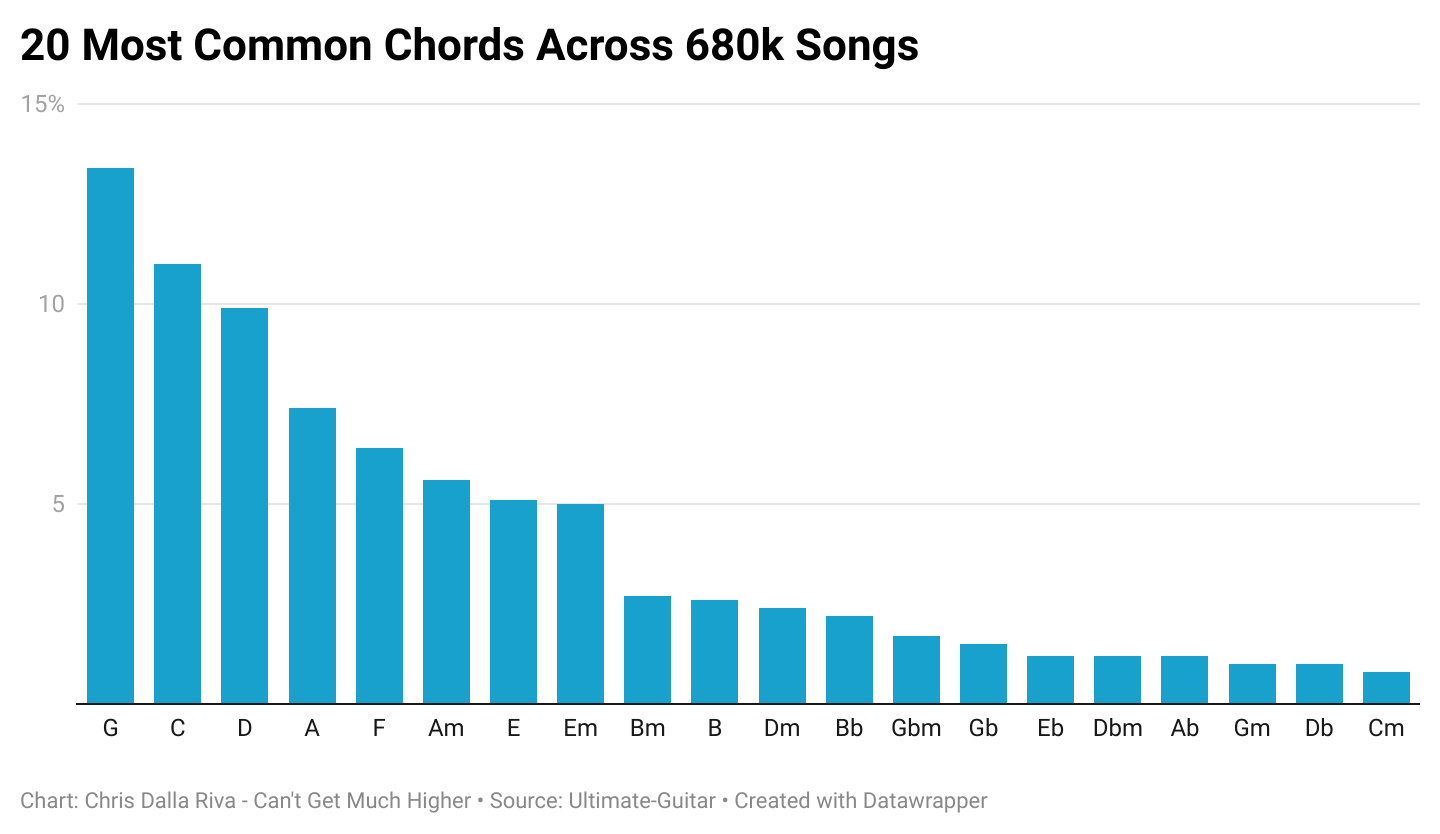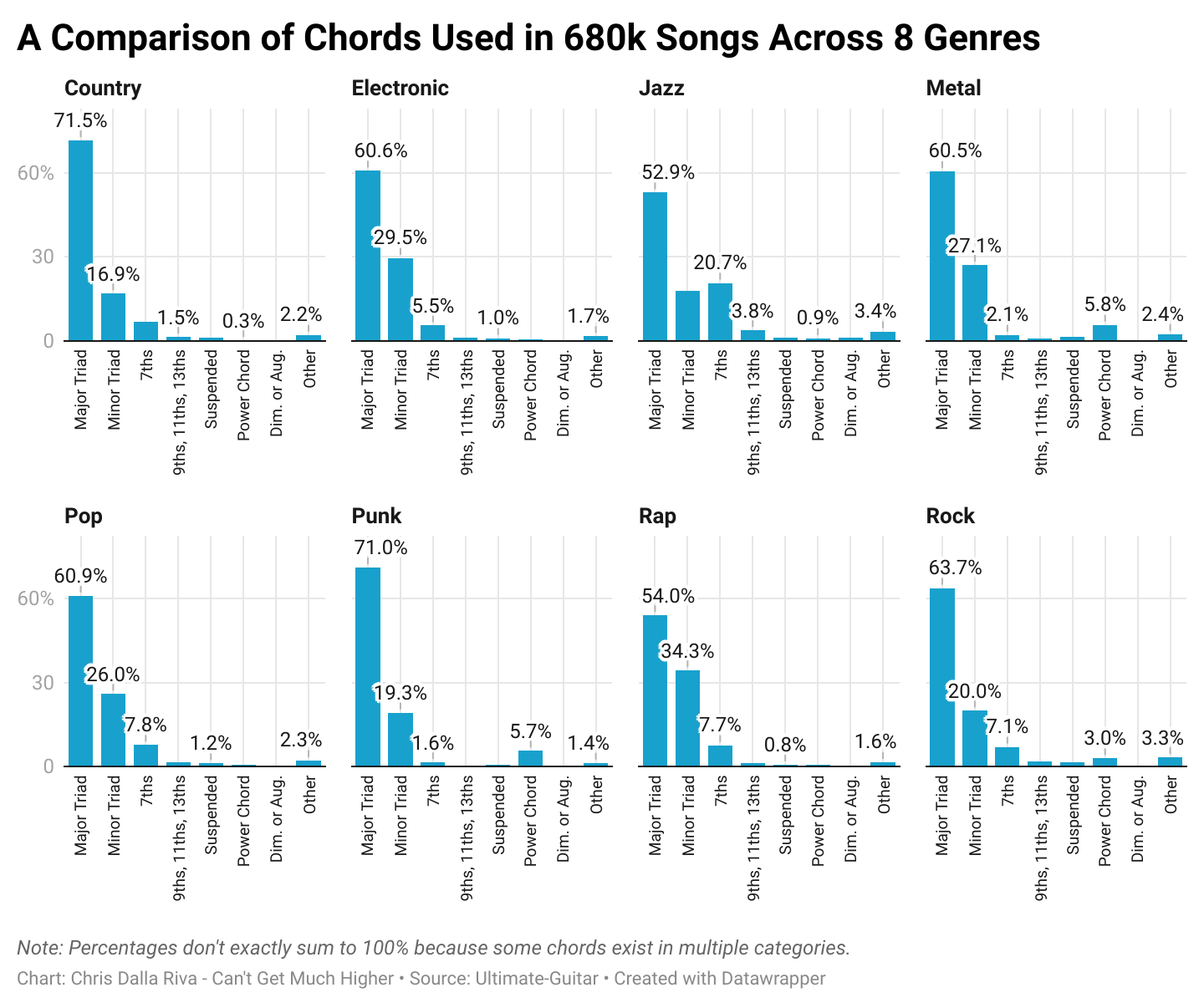[ed. No, but Cryptonomicon did. Please read it, everyone.]
“Chordonomicon” was coined by 5 researches last October when they needed a name for a new project that they’d just completed. This project pulled together chord progressions and genres for nearly 680,000 songs from the popular music learning website Ultimate-Guitar. I knew I had to do something with the data. But what? (...)
“Chordonomicon” was coined by 5 researches last October when they needed a name for a new project that they’d just completed. This project pulled together chord progressions and genres for nearly 680,000 songs from the popular music learning website Ultimate-Guitar. I knew I had to do something with the data. But what? (...)
Typically, when I write a data-driven piece for this newsletter, my approach is somewhat scientific. First, I have a hypothesis, like “there has been an increase in music biopics over the last few years.” Then I find some data to test that hypothesis. Whether I’m correct or not, I publish the results. For example, when I looked at music biopics, I found that on an absolute basis there was a dramatic increase over the last few years, but on a relative basis, the peak was in the 1940s.
I didn’t really have a hypothesis to test with the Chordonomicon dataset, though. I just wanted to explore what was in there. There had to be something interesting among 680,000 chord progressions. And there was. But, first, we should start with a simple question: What’s a chord?
If you’re looking for in depth discussions on music theory, I’m not your guy. (You should probably turn to someone like Ethan Hein and his newsletter Ethan teaches you music.) But for this case, I think some basic definitions will help. A “note” is a single pitch. When you hit one key on the piano, for example, you are playing a note. An “interval” is a combination of two notes. A “chord” is a combination of three or more unique notes (e.g., a C major chord is comprised of the notes C, E, and G).
Above you can see a breakdown of the top 20 most common chords across the nearly 52 million chords notated in the Chordonomicon dataset. If you’ve ever played a guitar or piano, you won’t be surprised by the fact that G major and C major are at the top, accounting for 24% of all chords. These are some of the first chords you learn on those instruments. What’s interesting is that chord choices differ when you look across genre.
Below you can see a usage comparison of 20 common chords in jazz and country. The differences are stark. In country, for example, five major chords — G major, C major, D major, A major, and F major — comprise 61% of all chords played. Among jazz songs, by comparison, those chords only make up 39% of total chords. Nevertheless, if we take a look at some other chords, the relationship flips. Bb major, for example, makes up 2.6% of all chords in our jazz sample. For country, it’s 1.4%, almost half.
I didn’t really have a hypothesis to test with the Chordonomicon dataset, though. I just wanted to explore what was in there. There had to be something interesting among 680,000 chord progressions. And there was. But, first, we should start with a simple question: What’s a chord?
If you’re looking for in depth discussions on music theory, I’m not your guy. (You should probably turn to someone like Ethan Hein and his newsletter Ethan teaches you music.) But for this case, I think some basic definitions will help. A “note” is a single pitch. When you hit one key on the piano, for example, you are playing a note. An “interval” is a combination of two notes. A “chord” is a combination of three or more unique notes (e.g., a C major chord is comprised of the notes C, E, and G).
Above you can see a breakdown of the top 20 most common chords across the nearly 52 million chords notated in the Chordonomicon dataset. If you’ve ever played a guitar or piano, you won’t be surprised by the fact that G major and C major are at the top, accounting for 24% of all chords. These are some of the first chords you learn on those instruments. What’s interesting is that chord choices differ when you look across genre.
Below you can see a usage comparison of 20 common chords in jazz and country. The differences are stark. In country, for example, five major chords — G major, C major, D major, A major, and F major — comprise 61% of all chords played. Among jazz songs, by comparison, those chords only make up 39% of total chords. Nevertheless, if we take a look at some other chords, the relationship flips. Bb major, for example, makes up 2.6% of all chords in our jazz sample. For country, it’s 1.4%, almost half.
What explains these differences? Of course, some of it is connected to arbitrary compositional choices. But another piece is explained by the instruments used in each genre. For example, the trumpet is commonly used in jazz, and trumpets are tuned to Bb. Similarly, banjos and guitars are common in country. Banjos are tuned to open G, and, as noted, chords like G, C, and D are some of the first you will learn when picking up the guitar.
Looking at individual chords across a bunch of genres is a bit chaotic, though. Instead, we can group chords into a few categories to make cross-genre comparisons a bit more digestible. Below we can see that while your simple, three-note major chords (e.g., A major, Db major) are the most common across every genre, there are some stark differences in other categories. 7th chords, for example, are 2.5 to 13 times more common in jazz than any other genre. Similarly, power chords are 2 to 21.5 times more common in punk than any other genre. Furthermore, Suspended, diminished, and augmented chords basically don’t exist in rap.
But it’s not just interesting to compare these chord categories across genre. It’s interesting to compare them over time. Below you can see the prevalence of each chord type by decade from the 1930s to the 2020s. The most striking trend is that 7th chords have fallen into disuse. In the 1940s, 27.7% of all chords were 7th chords. Thus far in the 2020s, only 8.25% are. This decline is largely connected to the decline of jazz, a genre where the 7th chord family was a defining feature. As jazz has lost favor, simple minor triads (e.g., E minor, Ab minor) have become more prevalent.
by Chris Dalla Riva, Can't Get Much Higher | Read more:
Images: the author



